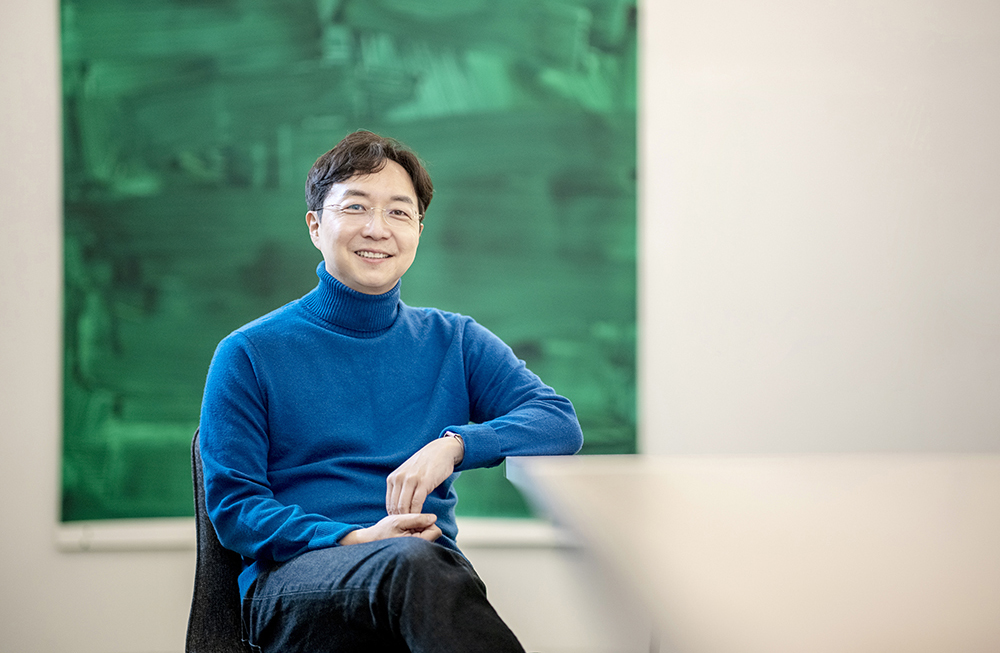- Architecture Designs Relationships December 29, 2021
-
Yoo Hyun-joon (Architectural Engineering, Entering Class of '88), Architect Who Changes the Relationships
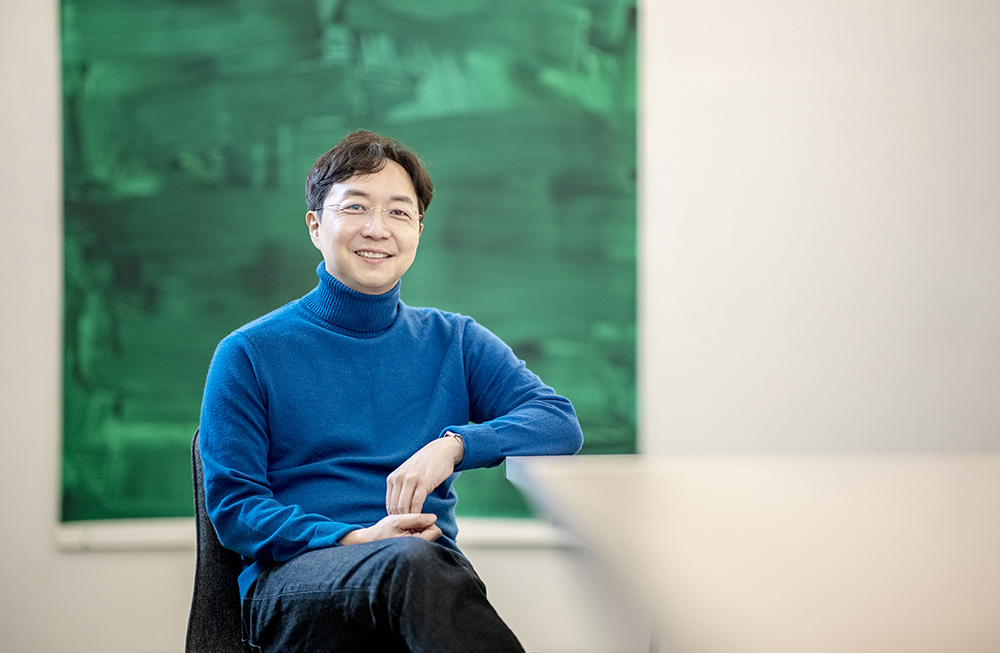
An Architect Who Sees the Essence of Architecture
While walking along the street, you come across some unique, magnificent, or sophisticated buildings on the street. You might think that architecture is just about constructing such wonderful-looking buildings. However, we often overlook that our lives unfold within and outside these numerous buildings, be it our homes, streets, offices, or parks in the neighborhood. As we open a door, we see a street; walking on the road, we enter a store or sit on a bench for a while. As we open a window in our offices, we can also see trees in a park across from. Architecture is to design the interactions between people and space in our lives. Nice-looking buildings are meaningful in some ways, but the essence of architecture is "relationship." A Yonsei University alumnus Yoo Hyun-joon is an architect who knows that essence and expresses it better than anyone else.
Campus Life: Immersed in Architectural Design
Yoo's decision to major in architectural engineering was thanks to his temperament. Rather than subjects where there was always a correct answer for each question, such as mathematics, he loved to approach and dig into subjects that are more intrinsic in nature, such as art, geography, earth science, and physics, and to express his views from a different perspective. Since he was young, Yoo also enjoyed the process of creating something new, so much so that he once dreamt of becoming an inventor. Architectural engineering was the intersection of areas of his interests. With the liberal atmosphere of Yonsei University, Yoo was able to have the desired opportunities to express his thoughts as an architecture major.
"I remember the architectural design class being the most fascinating learning experience. The class required students to put their ideas into an actual architectural design. And the professors were extremely flexible in that they did not attempt to inject their thoughts in any way. There was a freedom to develop an original idea and the autonomy to study the subject in my own ways, and the opportunities for us to critique one another's works helped a lot."
Moving on to his sophomore year, as Yoo began taking in-depth courses for his major, his interest in architectural design grew more and more; he was officially a full-fledged, passionate architecture major. It was to the point where he decided to "not invest any thoughts into anything apart from architectural design," He did not want to care about anything other than designing, so he decided on clothes to wear for a week every Sunday night and wore that single set of clothes until Friday. However, even Yoo, with such a strong passion for his studies, recalls having difficulty preparing for his graduation piece, just like his peers.
"Back then, the architectural design class was accountable for just three credits. But it required the effort and time worthy of around 30 credits of courses. I remember not being able to take a shower for nearly two weeks as I prepared for my graduation piece. I was somehow anxious that taking a shower would break my concentration. I would collapse into sleep after spending the whole night working on the piece, and I would wake myself up to resume working. The result of such effort was "Analog v. Digital," designed to express the balance and convergence of human intuitive and qualitative thinking with rational and logical thinking. It was a design of a space with a library on one side and a place for contemplation on the other."
His work, which saw the light of day after much contemplation and passion, won the honor of winning the Korea Architecture Exhibition. At that time, when there were few architectural contests, the Korea Architecture Exhibition was a venue for a showdown among all the outstanding architecture students from all over the country. It was indeed a big sensation, with three Yonsei students, including Yoo, winning the award, which had not won the award for a while.
"Until then, there was a perception that Yonsei University did not emphasize the architectural design field. My senior Minsuk Cho, now a famous architect, received a special selection many years ago before us, and there was no award after a while; then, three of us from Yonsei won the awards. It was the first time for the Yonsei architecture department to receive a large number of awards. Since then, our university's status has changed drastically regarding architectural design. Also, senior students started studying in Ivy League schools such as Columbia and Yale around that time. The most prestigious universities overseas, considered high thresholds, were places where we could actually go."
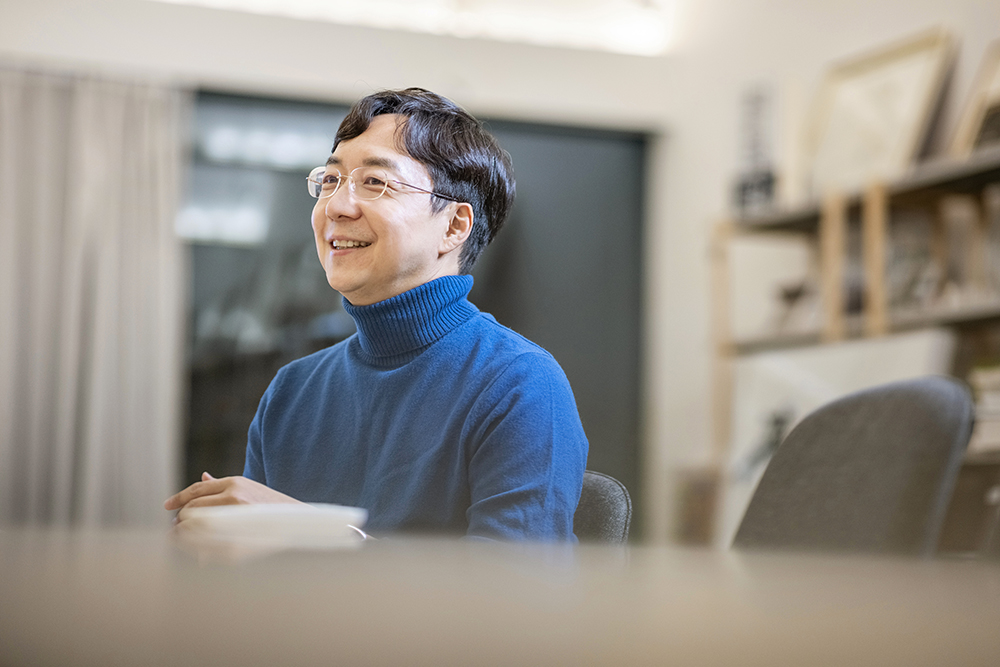
Time of Growth along with the World's Best Talent
With many senior alumni successfully standing out after pursuing their studies abroad, Yoo aspired to follow in their footsteps. It was as if life at the Ivy League schools he saw in the movies was becoming closer than ever. Above all, he desired to immerse himself in competition with the world's best architects on a global scale. Such aspiration led him to pursue further studies abroad to earn master's degrees in architectural design from the Massachusetts Institute of Technology (MIT) and Harvard University, respectively. Being exposed to the different atmospheres and curriculums of two of the most prestigious universities in the Ivy League schools, Yoo strengthened his architectural competence.
"The MIT Department of Architecture is the oldest architecture school in the United States. They study how to engage in a new form of construction by introducing new technologies early on. At MIT, you can experience both the school ethos of studying the application of very innovative technologies, such as artificial intelligence and the pursuit of very traditional methods that suit the school's long history. Also, through the world architectural travel program, which was held every vacation, I had the chance to see major buildings around the world, such as the pyramids of Egypt, the Opera House in Sydney, and the Inca civilization in Peru, and it was a huge inspiration for me. On the other hand, Harvard was like a modern Bauhaus style. Unlike MIT, where the architecture major was a small group, there were many students at Harvard, so there were more than 20 architecture studios. I could learn from the various projects that about 200 students were working on simultaneously."
Friendly competition with talents gathered from all over the world has enhanced his capabilities and broadened his perspectives. Yoo's passion for architecture and hard work led him to receive an honors degree from Harvard and the chance to work at the studio of world-renowned architect Richard Meier. It was a "dream come true" moment for him.
"A professor at Harvard once told me, "If you have an architect who has a career you would like to have, there's no chance of it becoming a reality without working under that architect." Richard Meier has been an idol to me ever since I was an undergraduate at Yonsei, and I had the privilege of being selected based on a paper on housing that I wrote. Working with him at his studio has allowed me to gain confidence in myself, with the belief that 'I can become someone like him in the future.' "
During his time at Richard Meier's studio, Yoo participated in various projects. His most memorable project among them was the Charles Street Apartments in Manhattan, New York. He felt a thrill during every process involved in turning his blueprint into actual buildings. He went back and forth between theory and practice by adjusting the differences between the design drawings and the on-site construction process and solving the things to be coordinated. Participating in the Ara Pacis Museum in Rome was also an extraordinary experience as it was the first construction project for a new building in downtown Rome, Italy, ever since World War II.
After two years with Richard Meier, Yoo decided to return home. Above all, he wanted to do something of "his own." Yoo was appointed as a professor of architecture at Hongik University, a perfect opportunity with one of the prerequisite conditions for appointment being the operation of a private architecture studio on top of conducting lectures at the university. Since his appointment in 2005, he has been continuing his life as an educator at Hongik University while carrying out his own projects.
Architecture is Based on Relationships, Not Style
For Yoo Hyun-joon, architecture is about "designing the relationship." As such, he believes that a good architect is an individual who can orchestrate relationships.
"Architecture should always consider relationships. It has to unravel, coordinate, keep appropriate distance, and even break some complex relationships between people, between society and people, and between nature and people. And there should be an "eye to see." If no one has it, society will be ruined. Some architects will look at architecture focusing on forms, but I value "relationship" the most."
He is wary of the appearance of a formative style that might reveal his "signature" in the architecture he designed. He instead hopes that such a signature would not exist in any way. Rather, by focusing on invisible relationships, he contemplates ways to resolve these relationships through architectural elements such as stairs, windows, and walls. Depending on the combination of architectural elements, new results would come out every time; through this, the relationship between people can also change. By taking a close look at his works, a terrace like a tree-planted yard, an apartment where you can see a room from another room, an apartment where you feel like reading a book under the shade of a tree, and a school resembling a village where houses with a yard are gathered, we can see how much he weighs in on this "relationship."
His recent project, "All the Benches in the World," which has taken place on Teheran-ro (Tehran Road) in collaboration with the Gangnam-gu (District) Office, involves setting up various benches in the forest of buildings for pedestrians to take a moment of pause in the busy street and share their time with others. Fifteen unique benches have been installed, including one designed by Yoo, who claims to be a "bench evangelist" who identifies benches as a small element that can change the relationship of space. While unknown to most, Yoo was the designer behind the bench space in front of Yonsei University's College of Engineering. By placing a bench in a small empty space, there are experiences where space and people, and people and people can interact; in other words, "relationships" are being formed. That is a kind of "event."
With Yoo valuing relationships in architecture to such an extent, it is no surprise that he looks into and talks about architecture in the context of humanities, society, and economics. He has published many books, including What Cities Live By, Where Do You Want to Live, Space Created by Space, and Future of Space. He has also created his own YouTube channel, "Sherlock Hyunjoon." Through various media, he is enabling a wide range of audiences to have easy and fun insights into people and architecture, based on his faith that our cities can change only when anyone can talk about architecture naturally in their daily lives.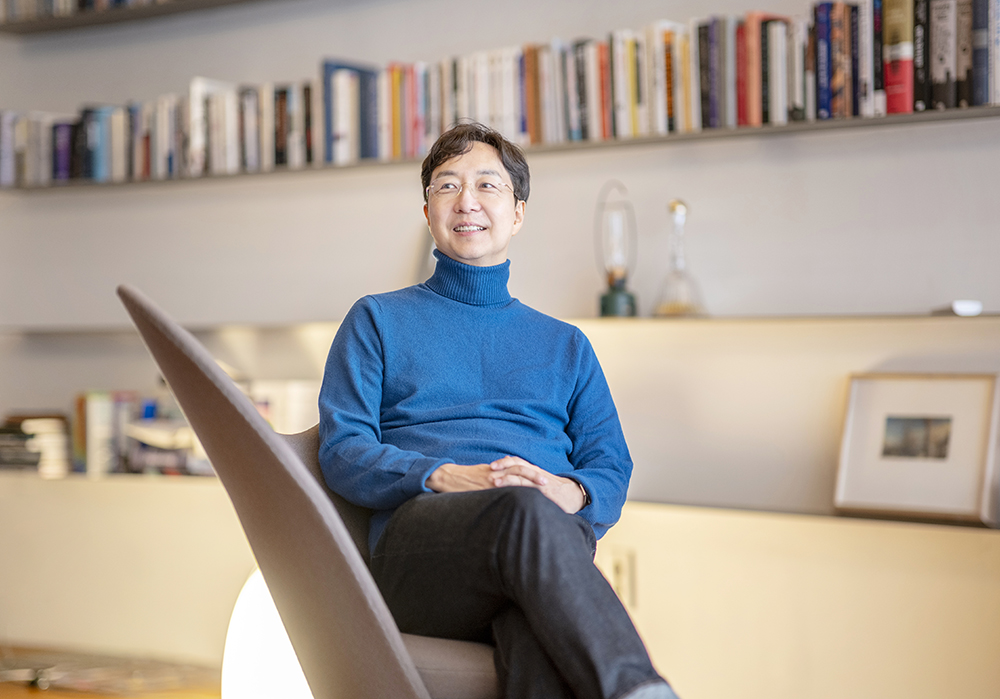
Transformation into a City Full of Color
For Yoo Hyun-joon, who designs "relationships," cities where people and buildings are concentrated, especially Seoul, are always attractive and challenging spaces. In particular, he believes it is time for the landscape of buildings and apartments in Seoul, built to pursue efficiency in the era of rapid modern industrialization without much consideration, to change.
"I think the apartments themselves are not a problem, but their monotony is an issue of concern. During the period of economic growth, South Korea was built through the standardization and mass production system, which led to us having standardized housing. Because all the houses look the same, my house and my unique value cannot be seen. This leads to the standard of value judgment solely being the price of a house. In urban environments, densely populated apartments are surely needed in terms of commercial interests and efficiency. Building these apartments is fine, but why don't we build them in various styles? For instance, building an apartment for 3000 households can increase its unique value by involving multiple construction companies. If you look at the houses in Santorini, Greece, they all seem similar but have slightly different characteristics. In Manhattan, New York, skyscrapers are not only built to differ in shape but also face slightly different directions. That's why it looks more lively and beautiful in those places."
With such thoughts in mind, he is also preparing a documentary about apartments recently. He wants to introduce various types of collective housing around the world, hoping to find a solution to help diversify the Korean apartments that are built.
Should We Preserve or Demolish?
South Korea's urbanization was mainly carried out at a rapid pace in the 70s and 80s. Now, about 40 years later, there are new and old buildings coexisting in the city, and some places are even degenerating. As such, issues regarding urban regeneration and reconstruction continue to arise. This conflict, which is always sharply confronted, lies between "whether it should be preserved" and "whether it should be demolished and rebuilt." Though Yoo finds significance in the arguments of both sides, he urges us to have a different perspective on the issue.
"The places that we regard as our role models, such as London and Paris, are collections of buildings built with all the world's wealth in the past. They can't be rebuilt. They should be preserved. But in South Korea's case, we have many buildings built in a short period when the nation wasn't so affluent. Sewoon Plaza in the old city center is a typical example. I don't think it's necessary to preserve it simply because there are memories regarding it. If we don't want to destroy it all, I hope there would be flexibility to embrace diversity by preserving the shape of the alley while rebuilding the surrounding area. I think we should be bold when it comes to demolishing the areas where new projects can begin."
"Gentrification," which occurs in underdeveloped areas, is also one of the problems in cities. The influx of young designers and artists into the low-rent, underdeveloped areas might bring about the transformation of spaces to be trendy, but with the rising value of real estate following the trend, rents would also rise, eventually forcing the indigenous people or artists who have raised the value back to the outskirts. He also presents a new perspective on this phenomenon.
"I think people who are being forced out should become more strategic. In fact, gentrification is a phenomenon that happens anywhere in the world at any time. Fundamentally speaking, the way to solve it is to become the owner of a building where you operate the business. It would be a great solution for young people if they could create a joint fund to purchase the buildings or for several store owners to work together to buy them. By looking two steps ahead and buying a cheap building in the slum to transform it into something unique, we can make a better world with greater value."
An Architect in the Non-Face-to-Face Era is an Insightful Coordinator
The non-face-to-face era has been accelerated by the global COVID-19 pandemic, where individuals feel greater comfort in online spaces. Considering that architects would have to build actual, physical buildings in offline spaces, what would be the future that awaits them in this rapidly changing era?
"In fact, it depends on how we define it. While the early artists were expected to draw an object as realistically as they could, their role changed after the camera's invention to expressing their thoughts on the canvas. Likewise, I do not foresee that architects will play the same role in the future. More decisions about the design will be made by artificial intelligence. There are already too many good designs in the world, and now we are in need of the ability to choose and coordinate them to ensure practicability. An architect's role would gradually place greater emphasis on seeing the bigger picture, making insightful judgments at a deeper level, and carrying out the relevant coordination."
Metaverse, an online virtual space, comes as a new opportunity. After all, since architecture is about coordinating relationships, it can be applied online as well. Metaverse, contrary to our belief, is not a zero-gravity space that is entirely out of touch with reality; instead, it is a virtual space built based on our current experiences in the real world. This also means that the field of architecture in real life can expand itself into the realm of the online world, just like how Yoo Hyun-joon was recently appointed to design a virtual space for the "LG Signature Art Gallery" in 2020.
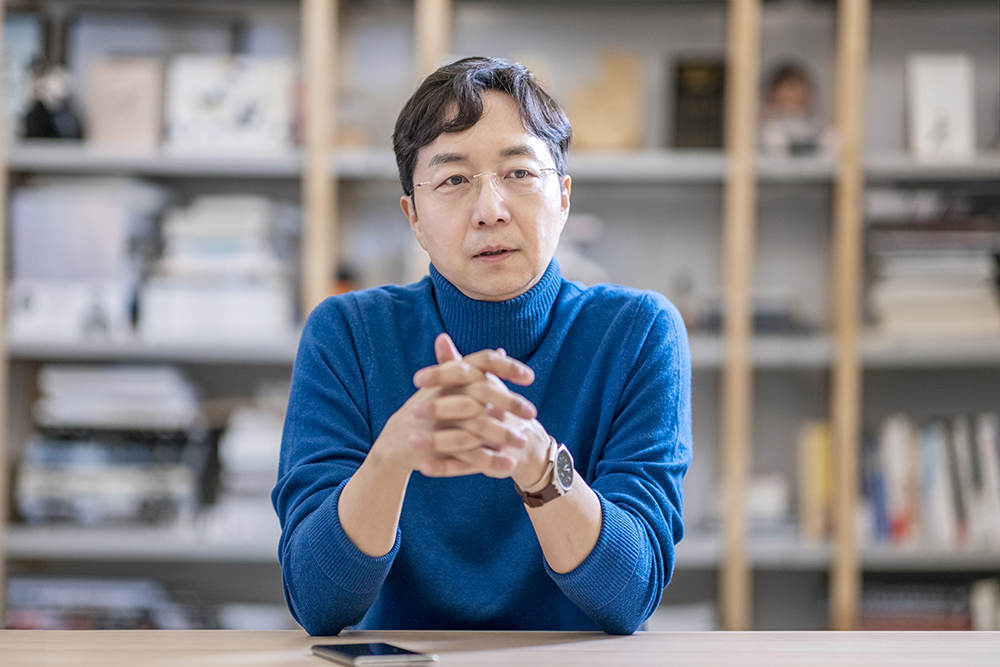
To Make the World a Better Place to Live
As of now, a wide range of projects from residential houses, buildings, apartments, government offices, and residential neighborhood facilities have accumulated into a pile of the portfolio in Yoo's studio. Projects that have been under design for approximately three to four years are now planning to begin their construction. Though there are countless forms of buildings, he has always had the ultimate goal of designing a "new type of housing" as an architect.
"A house is a stem cell of all architecture. If a house has several rooms, it becomes a hotel, and if there is an enlarged living room, it becomes a convention hall. Since a house is a subject for which the design philosophy of an architect can be directly reflected, it is a desire for me to design a house that distinguishes itself from the rest. World-renowned architects such as Frank Lloyd Wright and Le Corbusier may have designed many great buildings, but their signatures are still considered to be housings such as the "Falling Water" and "Villa Savoye." This is an achievement that I wish to have for myself as well."
While he is writing books and making appearances in various media amid his life in the studio and university, his heart lies in his primary occupation as an architect. In fact, that is why he is trying to expand his exposure to the public through such diverse channels. Stating that he would "continue to discuss architecture to the public till the day when it pops out as a topic of discussion among men in their 20s as they drink," he hopes that citizens can raise awareness of better places to live by developing an eye for architecture. After all, understanding space means knowing how to enjoy it to the fullest, as the relationship between space in daily life and people can eventually change our lives and society to be more abundant.
Alternatives Accumulate to Become the Best
Considering Yoo's background, with a history of studying in prestigious schools with a brilliant award-winning career, and his current status as a renowned professor who is also a best-selling author, it seems natural to think that his life has been a smooth-sailing journey throughout. However, he states that there has never been a moment in his life when things went as he originally planned. It was the realizations from these processes of dejection that he wished to share with his junior Yonsei students filled with insecurities about the uncertain future.
"I actually applied to both Harvard and MIT as I was preparing to study abroad, but I missed out on my application to Harvard, which eventually led to being enrolled in MIT. It was a shame back then, so I ended up doing my master's degree once again at Harvard. After finishing my studies, I wanted to come back to Korea to be engaged in my own projects, but I chose to be a professor because I was responsible for supporting my family. I wished to be appointed as a professor at Yonsei, but that did not turn out well. It was upsetting back then, but I'm grateful to think of it now. Thanks to going to MIT, I learned something else that I couldn't learn at Harvard, and I was able to teach and work at the same time as I was hired as a professor at Hongik. I had a hard time in the early days because I was not assigned any projects, but because I had much time, I could write books that received good responses. My life never went according to my wishes, and the advice I want to give to my juniors is that even if life doesn't go according to the best plan, the second-best alternatives will gradually accumulate to become the best. In particular, those in the architectural design field would feel anxious while having doubts about themselves every second. It was not an exception for me, but I just endured it. But I've achieved a lot more than I expected at 25. Following the road that opens up as you go, the alternatives would eventually guide you to the best path sooner or later."
Yonsei alumnus Yoo Hyun-joon is convinced that being an architect is the best job in the world. Being an architect was a great decision as no specific answer was set. He felt happiness in interpreting, imagining, and expressing the world with physical architecture from a different perspective. Engaging in architectural design that involves contemplating the relationship between space and people still comes as a great blessing for him, which might be why we would continue to look forward to seeing what new relationships and "events" he will create in the future.
show mobile menu
mobile menu

